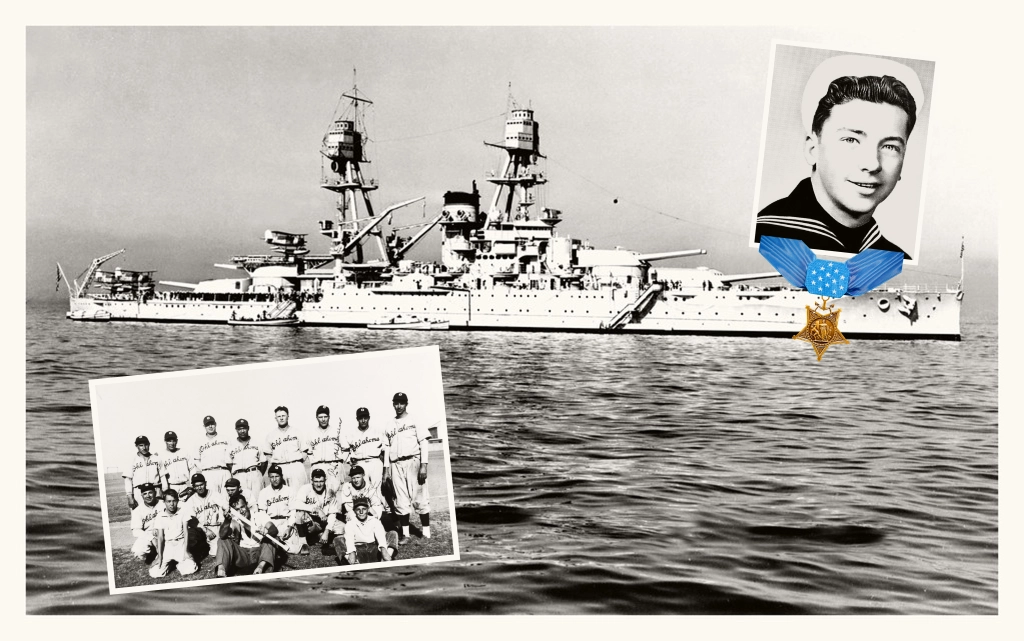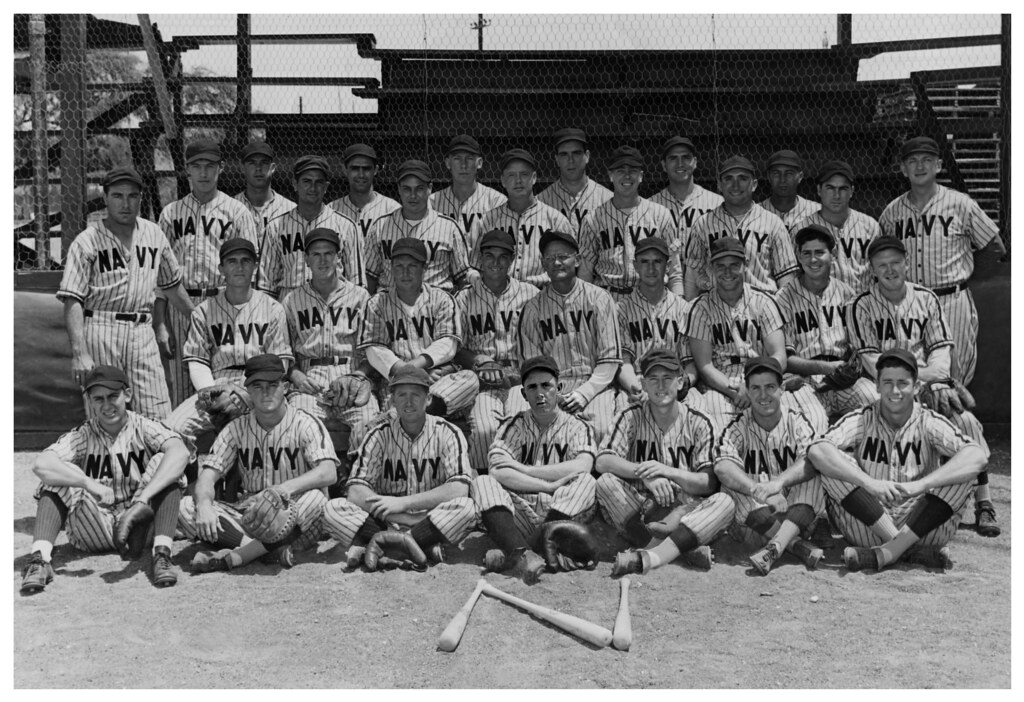Perhaps one of the most highly sought-after categories of baseball militaria is bats that were provided to and used by troops during World War II. Capping off the collection of a complete combat uniform on a mannequin, including all the soldier’s carried equipment, a Special Services U.S. Army-stamped baseball bat and glove provide the arrangement with an honest representation of what would have been seen in Europe when the soldier was between campaigns. Such baseball equipment provides exhibits with authenticity as baseball was an essential element among the troops in more ways than just recreation. For Navy and Marine Corps displays, the same holds true with U.S.N.-marked baseball lumber.
The game derives its name from the one piece of equipment that has the potential to be touched by every player on the field regardless of the participant being on the offensive or defensive side: the ball. However, the bat is the instrument that is used to put the ball into play, sending each player into motion once the ball makes contact with it. Runners on base and fielders spring into action following the crack of the bat against the hide-covered ball. “If you go to the New York Metropolitan Museum, you will see the knights of the old days with their spears, their weapons of choice. Baseball’s weapon of choice is the bat,” esteemed baseball collector Marshall Fogel stated in an interview for Episode 1 of Collectable TV’s The Greatest Collectors series.[1]

The connection between a weapon and a piece of game equipment is perhaps closest in the realm of the baseball militaria genre of collecting. With its obvious hobby crossovers between militaria and baseball memorabilia, baseball equipment stamped with military markings draws considerable collector interest. Baseball’s weapon of choice can bear an array of markings, including “U.S.,” “U. S. Army,” “Special Services U.S. Army,” and “U.S.N” to signify the branch of service in which the bat was distributed during WWII. While a variety of bat manufacturers provided bats to the armed forces, the overwhelming majority of the lumber seen on domestic and combat theater diamonds was made by Hillerich and Bradsby (H&B). While the War Department’s acquisition focus centered on acquiring ships, aircraft, munitions and personnel, baseballs, gloves, bats, and other sporting equipment were provided to troops through means outside of normal governmental funding and requisitioning. As the war-fighting funding was sourced through tax revenue and war bonds, recreation equipment money was generated through external programs.

“Baseball’s contribution to the soldier boys will not cease until the war is over,” Washington Senators owner Clark Griffith said in the days following the United States’ entry into World War II. Griffith, who during the first World War established and oversaw the Bat and Ball Fund to provide overseas-deployed American troops with baseball equipment, commented about the efforts begun by mid-December, 1941. “That was my own effort,” Griffith said of the WWI fund, “but this time, all of organized baseball is supporting the plan.”[2] Baseball did indeed take an active step in directly supporting members of the armed forces at the war’s onset. On December 16, 1941, major league baseball announced that it was committing $125,000 for a bat-and-ball fund to provide equipment to men in armed forces training camps and had already paid $25,000 into the program.[3]

During the major league winter meetings, as the Giants negotiated a trade to obtain the Cardinals’ power-hitting first baseman Johnny Mize, the owners proposed doubling the prices of the 1942 All-Star Game, scheduled to be hosted at Brooklyn’s Ebbets Field, with all receipts to be directed to the Bat and Ball Fund.[4] With seating limited to 35,000 fans, Dodgers president Larry McPhail planned to expand capacity in order to meet his goal of raising $100,000 for the Bat and Ball Fund during the “mid-summer classic.” McPhail also predicted that the fund would collect $500,000 from major league baseball by the end of 1942.[5] Joining the fund-raising effort, the International League announced its first-ever all-star game to be played on July 8 in Buffalo, New York, with 75 percent of the proceeds slated for the U.S. Army [relief] Fund. With two of the league’s clubs, the Toronto Maple Leafs and Montreal Royals, based in Canada, 25 percent of the proceeds were to be directed to the Canadian Army Fund.
By the war’s end, the armed forces had received an abundance of equipment, including millions of baseballs and also bats and gloves numbering in the hundreds of thousands. Unfortunately for collectors, specifics regarding production numbers and distribution across the branches of the armed forces are not available. With the considerable number of bats produced by H&B for the armed forces, it is reasonable to assume that more pieces were delivered lacking branch markings than the number of those bearing stamps. Production and distribution data provide collectors with a baseline in gauging the potential for scarcity of surviving numbers and yet demand for specific markings drives the values of those pieces.
Market interest in wartime bats began to pick up late in 2019 and mirrored the trends of the baseball memorabilia market. Of the service-marked lumber, those marked with “Special Services U.S. Army” garnered the most attention, which drove values to between $200-700 depending upon condition and player endorsement.[6] While scarcity is often a factor in driving values, in the absence of demand, it can have little influence on the price of an item. There are a handful of smaller bat manufacturers who supplied the armed forces with equipment in smaller numbers than H&B. They attract marginal interest from collectors and leave prices consistently below the $50 threshold. After years of searching, a scarce H&B wartime-marked bat finally surfaced.
In early March, a reader published a comment that immediately grabbed our attention. “Hello. I recently acquired a Louisville Slugger 40 BR Babe Ruth bat marked Professional Baseball Fund,” the comment began. “I assume it was produced for military personnel (based on reading a post on baseballs),” he continued. “Any ideas?” he asked.

Could this be one of the marked bats that we had been seeking? Uncertain if any of these survived nearly eight decades, an email was promptly dispatched, seeking photographs of the piece in question. The response answered the question. Since our collection already featured two of the scarce Professional Base Ball Fund-marked baseballs, the marking on the bat clearly matched and confirmed suspicions. The photos included close-in captures of the center brand and the player endorsement stamps. The model 40BR was a retail or “store-model” bat and was lightly stamped with black foil instead of the burned-in, deep impressions featured on professional models. Unfortunately, a significant amount of the black foil was worn, which commonly occurs with game use, handling, and decades of oxidation. Other condition issues included considerable wear on the knob and barrel ends and a crack extending from high on the handle towards the barrel.



As the bat was an obvious candidate for the Chevrons and Diamonds Collection, we were pleasantly surprised that we were able to secure it rather than to see it hit the open market and risk seeing it fall prey to well-heeled collectors entangled in a bidding war. Entrusting the bat into the hands of a cross-country carrier, we awaited the arrival with considerable anxiety, hoping against loss or damage. The package arrived safely after more than a week in transit. After a thorough and careful examination, we decided against any intervening measures with the crack or the loss of foil in the brand markings and stamps. Preservation and stabilization are always a function of accepting artifacts into the collection, and so the next steps to be taken included a thorough surface cleaning and an application of linseed oil to prevent subsequent decay.

Baseball memorabilia and militaria collectors alike pursue the offensive weapon for numerous reasons. Fogel’s characterization of the bat as a figurative weapon resonates with those interested in pursuing them to highlight the game’s history with a very tactile, tangible artifact. “So, I knew from the beginning, doesn’t it make sense to collect the weapon that makes these guys great?” “That’s what got me interested in the war club, the bat.”[7]
More like an arbalest in that it propels the ball into play, these vintage wartime weapons continue to command considerable interest and subsequently increase values on the collector market. It is difficult to gauge a value for our Professional Base Ball Fund-stamped model 40 BR George “Babe” Ruth bat. However, recent sales of the more common models (absent military markings) have been for prices consistently above $500. Special Services U.S. Army-stamped pieces have seen highly competitive bidding, with auction close-values being more than $800. The Professional Base Ball Fund-marked bats are the scarcest of the Hillerich & Bradsby wartime bats. They could drive an appraised value in excess of $1,000.

Our bat has found a home in the Chevrons and Diamonds Collection for the foreseeable future and will be part of our public exhibition schedule in the local area for this year and in the future.
[1] The Greatest Collectors: Episode 1: Marshall Fogel, Collectable TV, February 24, 2022: https://www.youtube.com/watch?v=eWgcyOxSnHk&t=11s
[2] Profits of Star Game, The Times-Tribune (Scranton, PA), December 18, 1941: 38
[3] Now a Rose Bowl Game for Durham, N.C., The Birmingham News (AL), December 17, 1941: 16
[4] Bat, Ball Fund Voted $25,000, Chattanooga Times, December 12, 1941: 20
[5] Kease, Harold, The Cracker Barrel, The Boston Globe, January 19, 1942: 18
[6] Batting Around: Special Services U.S. Army Equipment Drives the Military Baseball Market, Chevrons and Diamonds, May 11, 2021: https://bit.ly/3M1tkl8
[7] The Greatest Collectors: Episode 1: Marshall Fogel, Collectable TV, February 24, 2022: https://bit.ly/3JHYlZE





Leave a comment